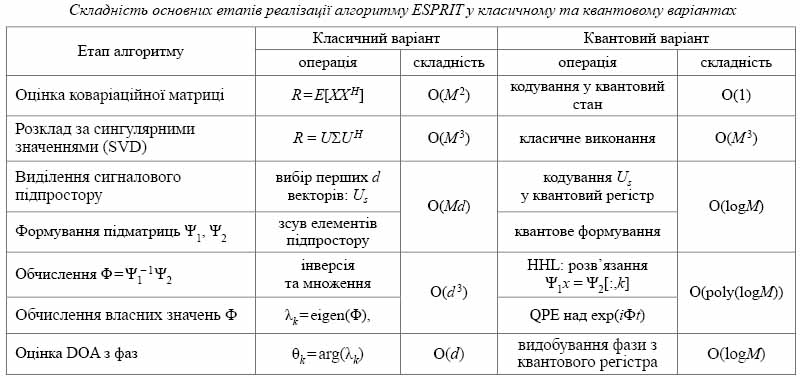Quantum approach to direction of arrival estimation
Abstract
The article analyses methods for determining the direction of arrival (DOA) of radio signals, particularly the MUSIC and ESPRIT algorithms. It is shown that the complexity of traditional approaches grows cubically with the number of antennas, which complicates their application in large-scale systems. The use of quantum algorithms for solving systems of linear equations and computing eigenvalues is proposed, allowing for a significant reduction in computational costs. The study examines the processing of complex matrices and presents a comparison table between classical and quantum versions of the algorithm in terms of computational complexity and structure.
References
Nan H., Ma X., Han Y., Sheng W. A computationally efficient MUSIC algorithm with an enhanced DOA estimation performance for a crossed-dipole array. Sensors, 2025, vol. 25, iss. 11, 3469. https://doi.org/10.3390/s25113469
Kulkarni S., Thakur A., Soni S. et al. A comprehensive review of direction of arrival (DoA) estimation techniques and algorithms. Journal of Electronics and Electrical Engineering, 2025, vol. 4, iss. 1. https://doi.org/10.37256/jeee.4120255708
Salman M.B., Björnson E. DoA Estimation using MUSIC with Range/Doppler Multiplexing for MIMO-OFDM Radar. arXiv preprint arXiv:2506.13258, 2025. Available: https://arxiv.org/abs/2506.13258
Wu L., Liu Z.M., Huang Z.T. Deep convolution network for direction of arrival estimation with sparse prior. IEEE Signal Processing Letters, , 2019, vol. 26, iss. 11, pp.1688 – 1692. https://doi.org/10.1109/LSP.2019.2945115
Meng F.X., Yu X.T., Zhang, Z.C. Quantum algorithm for multiple signal classification. Physical Review A, 2020, vol. 101, iss. 1, 012334. https://doi.org/10.1103/PhysRevA.101.012334
Horbatyi I. V., Usatyi O. А., Tsaitler B. М. Comparison of modern algorithms for determining the direction of arrival of a radio signal. Prooc. of the 26th ISPC «Modern information and electronic technologies», Odesa, Ukraine, 2025, pp. 8 – 9. Available: https://www.old.tkea.com.ua/siet/archive/2025/MIET_2025_08.pdf/
Zhou Q.Y., Wu J.W., Wang S.R. et al. Two-dimensional direction-of-arrival estimation based on time-domain-coding digital metasurface. Applied Physics Letters, 2022, vol. 121, iss. 18, 181702. https://doi.org/10.1063/5.0124291
Shmuel D.H., Merkofer J.P., Revach G. Et al. Deep Root-MUSIC: Towards data-driven Root-MUSIC DoA estimation. In: Proc. IEEE ICASSP 2023, pp.1 – 5. https://doi.org/10.1109/ICASSP49357.2023.10096504
Huang M., Li R., Zou Y. et al. A comprehensive review of metasurface-assisted direction-of-arrival estimation. Nanophotonics, 2024, vol. 13, iss. 24, pp.4381 – 4396. https://doi.org/10.1515/nanoph-2024-0423
Wang J.W., Huang Z.A., Wan X. et al. Polarization and direction-of-arrival estimations based on orthogonally polarized digital programmable metasurfaces. Journal of Physics D: Applied Physics, 2023, vol. 56, iss. 46, 465001. https://doi.org/10.1088/1361-6463/acee91
Horbatyi I., Usatyi O. Investigation of spread spectrum signal analysis methods in modern communication systems. Information and Communication Technologies in Electrical Engineering, 2025, vol. 1, iss. 9, pp. 125 – 129. https://doi.org/10.23939/ictee2025.01.125
Morales M., Singh A., Cao Y. Quantum Linear System Solvers: A Survey of Algorithms and Applications. arXiv preprint [arXiv:2407.05178], 2024. Available: https://arxiv.org/abs/2407.05178

Copyright (c) 2025 Ivan Horbatyi, Oleksandr Usatyi

This work is licensed under a Creative Commons Attribution 4.0 International License.
